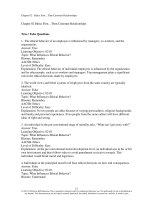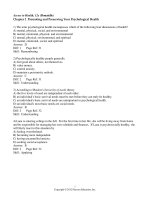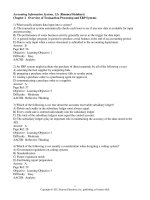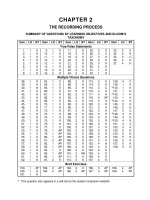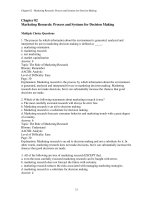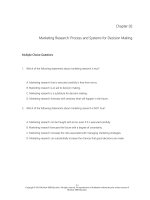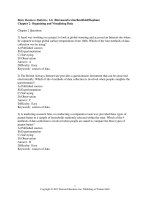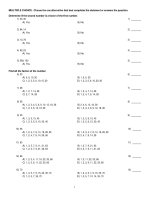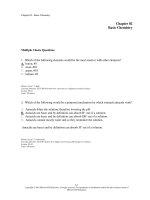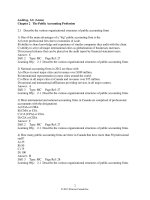Marketing research 12th edition aaker test bank
Bạn đang xem bản rút gọn của tài liệu. Xem và tải ngay bản đầy đủ của tài liệu tại đây (168 KB, 3 trang )
Test Bank
CHAPTER 2
Marketing Research in Practice
_________
True-False
1.
In practice, a marketing research department's goal can be grouped
into three major categories: Programmatic, Evaluative, and Selective.
T
2.
The purpose of an MDSS is to combine marketing data from diverse
sources into a single database for line managers to enter
interactively and obtain information.
T
3.
Standardized services are provided by companies that specialize in
just one or two aspects of marketing research.
F
4.
An information system is an interacting structure of people,
equipment, and procedures designed to disseminate timely, accurate,
and pertinent information to decision makers.
T
5.
Though MDSS leads to substantial cost savings, it does not lead to a
better understanding of the decision environment.
F
6.
Databases have value even if the insights they contain cannot be retrieved
F
7.
Analysis capabilities can be used to relate data to models but cannot be used
to identify exceptions and clarify relationships.
F
8.
The Starch Readership Survey is an example of a Syndicated Market Research Service
F
9.
The top US market research organizations have a significant majority of their revenues
coming from US based research operations.
F
10.
A good MDSS should be able to present data in a single format and at a single level alone
F
11.
A database typically contains data from all sources, stored in a sufficiently
disaggregated way so that it can be analyzed by products or geographic regions
or customers or by time intervals.
T
12.
MDSS can provide complex plots, charts, and other graphic displays
T
13.
Even if a company has an in-house research department, it is not unusual for it to
seek the assistance of external suppliers
T
Multiple Choice
1.
A syndicated research differs from a customized research in that
a) it takes less time to complete a research project
b) it is jointly sponsored by several different organizations
c) it provides more accurate data
d) none of the above
b
2.
________ are market research projects conducted in a standard,
prespecified manner and supplied to several different clients.
d
1
a)
b)
c)
d)
Customized services
Syndicated services
Branded products services
Standardized services
3.
___________ research is done to test different decision alternatives such as
new product concept testing, advertising copy testing, and pretest marketing.
a) Selective
b) Programmatic
c) Evaluative
d) Optional
a
4.
Which research is carried out to assess performance of programs,
including tracking advertising recall and corporate and brand image studies?
a) Selective
b) Programmatic
c) Evaluative
d) Optional
c
5.
Which of these is a continuing and interacting structure of people,
equipment, and procedures designed to gather; sort; analyze; evaluate; and
distribute pertinent, timely, and accurate information to decision makers?
a) database
b) information system
c) decision support system
d) none of the above
b
6.
Which one of the following can affect market research?
a) available resources to conduct research
b) the objectives of the sponsor
c) the decision maker’s understanding of the problem
d) all of the above
d
7.
___________ research is conducted to develop marketing options.
a. Selective
b. Programmatic
c. Evaluative
d. Optional
e. None of the above
b
8.
Evaluative research is used to
a. assess program performance.
b. choose between decision choices.
c. develop marketing options.
d. test decision alternatives.
e. none of the above.
a
9.
Marketing research firms that are involved only in data collection
are called
a. syndicated service firms.
b. standardized service firms.
c. customized service firms.
d. field service firms.
e. none of the above.
d
10.
A decision support system
a. retrieves data, transforms it into information, and disseminates
it to the user.
a
2
b. organizes, stores, and retrieves information.
c. gathers, sorts, and analyzes information.
d. stores, analyzes, and sorts data.
e. none of the above.
11.
Models are used to
a. test alternative marketing programs.
b. assist in setting up realistic objectives.
c. answer "what if" questions.
d. all of these.
e. none of the above.
d
12.
Firms that work with individual clients and help them develop and
implement a complete marketing research project are called providers
of
a. customized services.
b. syndicated services.
c. selective services.
d. field services.
e. in-house services.
a
13.
Selective service firms are
a. firms with specialized data collection and analyses procedures.
b. firms that specialize in just one or two aspects of marketing
research.
c. firms that collect only data for projects.
d. firms that selectively choose clients.
e. firms that provide routine information on various issues.
b
14.
When a firm specialize in just one or two aspects of marketing research such as
data coding or data editing, it is described as a _____ firm.
a)
selective services
b)
syndicated services
c)
branded products services
d)
standardized services
a
15.
PRIZM, a Claritas Corporation product that forms clusters of the population
on the basis of lifestyle and Zip Code classifications, is an example of:
a)
selective service
b)
syndicated service
c)
branded products service
d)
standardized service
c
16.
A good MDSS should have the following characteristics:
1. Interactivity
2. Flexibility
3. Orientation towards discovery
4. Friendly towards users
d
a. 1 and 2 only
b. 1, 2 and 3
c. 2 and 3 only
d. All of the above
3
